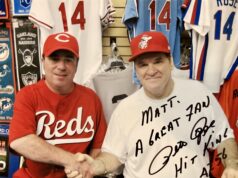View PDF ACEWeekly April 24, 2008 p 5
BY SPECIAL GUEST EDITOR MATT DACEY
Growing up in Albuquerque, heavy metal was ubiquitous, so I probably couldn’t have avoided it even if I had wanted to.When I moved to Lexington in 1985, the culture shock was overwhelming Albuquerque played host to one or two arena shows every month, with bands like Iron Maiden, Judas Priest, and
Rush passing through regularly. The first few shows I remember at Rupp after I moved here include Genesis, Bob
Seger, and Huey Lewis & the News. Not an umlaut in sight. As far as club shows, I was only 18, looked 15, and didn’t
know anybody, so that was out of the question. Radio was the same story, only moreso. In Albuquerque, I could tune in either 94 Rock or Rock 108, and hear bands like
Saxon and Accept, along with more prominent acts, every hour of every day.In Lexington, no such luck.There was only one rock station, and when they let their hair down, it was to play somebody like Night Ranger or Honeymoon Suite. I basically gave up on the radio and started spending a
lot of my time and all of my money at Cut Corner records. I first learned of the movement to start a student-run
radio station on campus during the Fall semester of 1986. It sounded cool, but I figured they would just play stuff like R.E.M. and the Beat Farmers all day long. It didn’t even occur to me at that point that they might actually play metal.
Early in 1987, that changed.
Radio Free Lexington had a booth set up in the free
speech area on campus, and Mark Beaty happened to be at the
booth when I walked by. I told him about a time when I had
called WKQQ and requested Black Sabbath, only to have the
DJ on the air hang up on me. Then I asked him if there was any
chance that Radio Free Lexington might play metal, and he
told me to come by the office in Miller Hall. I was just hoping
they would have a metal show; I had no idea I was gonna be
the guy to do it.But I went by Miller Hall, started hanging out,
and Radio Free Lexington adopted me as the token metal guy.
I joined about a year before WRFL actually hit the air-
waves.While I was the metal guy, I was also the music librarian,
and had the task of cataloguing and organizing the music library
as we acquired it, sometimes hundreds of records at a time.That
was my primary contribution to WRFLprior to going on the air.I also held the antenna as it was bolted down to the roof of the
Patterson Office Tower. Radio Free Lexington’s transition from student organization to radio station was a very exciting time to be both on
campus and in Lexington. The local music scene at the time was vibrant, and highly suportive of the WRFL move-
ment. Unfortunately, as the mmetal guy, I possessed a single-mindedness regarding music,
and my own apathy caused me mto miss out on a good number mof local shows that I had the mopportunity to see but chose not
to. My tunnel vision eroded, mthough, as other jocks exposed mme to a lot of different artists
that I probably never would mhave heard otherwise. WRFL expanded my horizons tremendously.
But not just mine. WRFL has had a profound and prolonged impact on Lexington.
Twenty years ago, Lexington had one commercial rock
radio station, and with all due respect, it sucked. Today,
Lexington has two commercial rock radio stations, and they
both play a much wider variety of music than the one station
did in 1988. And way more metal.
In 1988, Lexington had a very good independent record
store in Cut Corner, and a good portion of the staff was
involved in WRFL to some degree. Today, Lexington has one
of the best independent record stores in the entire country in
CD Central, and many of the people who’ve worked there
over the years have also been affiliated with WRFL.
The local music scene is somewhat more fragmented than
it was in 1988, but it is still vital.And WRFL still provides a reliable outlet where local musicians can have their music exposed
to a wider audience.
Many campus radio stations throughout the country only broadcast
during certain hours of the day, and/or only during the school year.WRFL has broadcast 24/7/365 for over 20 years. Maybe
I’m biased, but I think that’s amazing.
But then, WRFL has been very fortunate to continue to attract the people it has.Those of us who actually took the
station live knew our roles and responsibilities, and did what we were supposed to do.It was a
special bunch. The people who’ve come along since have been tremendous stewards of what we started.
I’ve had the opportunity to become acquainted with a number of those people over the
years, and their collective dedication to WRFL has never ceased to impress me.
The current staff is an amazing group of people. They knew full well that the 20th anniversary would occur under
their watch, and they were bound and determined to mark that anniversary appropriately. Visiting the station recently, I left with the feeling that I
had lent them my car, and they washed it before they returned it with a full tank of gas. WRFL still kicks ass. ■
Matt Dacey is the guest editor of this week’s issue, and will be on air on WRFL 10pm to midnight on Thursday (online at wrfl.FM).
Matt Dacey hosted Matt’s Metal Mortuary from 1988-1992, and is now the Customer Service Manager at the Beaumont Kroger. Matt is happily married to the former Kimberly Prenatt, and dad to Brady (age 8) and Claire (age 2).







